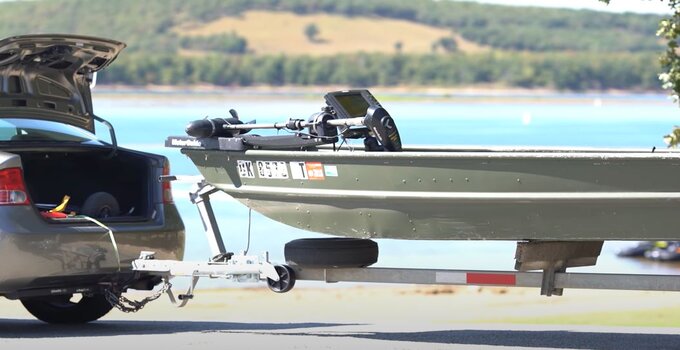Say no to Swaying by reading on.
Taking your bike with you on a journey is common and gives pleasure to your weekend. The bike gives a different pleasure to bike lovers and that’s why they hitch their bikes with them to their desired places.
Now often a problem arises your bike used to sway a lot whenever you are driving. Sometimes it creates some irritating noise as well which is quite disturbing when you’re driving. Also, it is insecure for your bike and car which can harm them, as well as if the connection is too loose your bike may be stolen by thieves.
To prevent these problems installing your bike on the bike rack is very necessary. We are going to give you the answer to why bike racks sway and how to prevent this problem easily. Read the article properly to understand everything.

What Causes Bike Racks to Sway?
Due to the connecting joints and the speed of the vehicle, bike racks can sway a little. The swaying can also be caused by the motion of a moving vehicle.
When hauling bikes in any vehicle, bike racks can sway. Due to the speed of the car, it should sway slightly. Furthermore, the bike rack’s attachments to the automobile are manual. It gives the arrangement some wiggle room. As a result, it tends to sway. It’s okay if your bike rack fluctuates a little. It should only play that is relevant to the content and does not produce a lot of noise or clink. It must not sway or produce excessive noise.
However, if the bike racks sway a lot, check the security straps as well as the nuts and bolts that connect the bike rack to the car.
Some basic reasons that cause bike racks to sway are:
- Bad receiver and hitch connection if this connection joint is not properly maintained.
- Bike racks are like an extra set of wheels for your car. Because of the momentum, the twists and speed of a car might cause the bike racks to shake.
- The vehicle can jolt a lot if you’re riding in a car with a bike rack over muddy and uneven roads. The bike racks may shake as a result of this shaking.
- If not secured, the bike racks’ connections to the vehicle can loosen. If these connections become loose and open up, bike racks might sway and create accidents.
- Different joints are present in the straps used to secure the bikes in the bike racks. If they are uneven for their size, the bike rack may wobble.
- The hitch and the bike rack are both made of metal. These metals can collide and clank when moving, especially if the nuts and bolts are loose. When in motion, it permits the bike rack to sway.
Also read: 6 ways to transport a Bike Without a Rack
Ways to keep bikes from swaying on the bike rack
By following these methods, you can keep away bikes from swaying on the bike rack.
After attempting all these steps try to check the nuts properly once again if it is properly tightened or not.
1. Install Hitch Clamp

Between your hitch-mounted carrier and your hitch receiver, the Hitch Clamp eliminates “play.” Designed to work with practically any luggage carrier, hitch-mounted bike racks, towing balls, motorcycle carriers, weight distribution hitches, flag mounts, and almost any other receiver-mounted accessory.
How to install Hitch Clamp?
A hitch clamp is the first solution you can attempt to reduce the swaying of your bikes So, how exactly does a hitch clamp function? It essentially clamps down on the tow bar of the rack and the hitch receiver of the car. Installing an anti-rattle mechanism in your bike racks is the simplest way to prevent them from swaying. A hitch clamp is another name for this device. It helps to keep your bike racks from swinging.
Here are the steps that how you can install a hitch camp on your vehicle:
- Take the metal plate, the U-bracket, and the required bolts first.
- Take the metal plate, the U-bracket, and the required bolts first. This metal plate can be used anywhere. Align the holes on the metal plate with the holes on the bottom of your vehicle’s hitch.
- By tightening the vehicle’s hitch connection, insert the U-bracket into the metal plate.
- In the open ends of the U-bracket, place a washer, lock washer, and nut. Using your hand, tighten the nut. Then, using a socket wrench, tighten and secure the attachment even more.
- Check the setup by moving the bike racks around with your hands to check if they wobble a lot.
- Check the straps you’re using to secure your bikes as well. To keep them from swaying, tighten them.
3. When using hitch bike racks, use anti-rattle devices
Anti-rattle hitch devices are simple add-ons that prevent hitches from shaking while the vehicle is moving. They come in a variety of shapes and sizes, including wedges, sleeves, and pins, all of which are designed to tighten the hitch until it can no longer rattle around.
Also read: Best 5 Hitchless Bike Racks for SUV
4. Install the bikes on the bike racks properly
Installing a bike rack properly provides a solid structure for your bicycle’s gear which can reduce your bike from swaying. If you position your bike properly on bike racks it may help a lot to reduce swaying.
5. Using the security straps, secure the bikes to the racks

To guarantee balance, you’ll need a basic locking strap and an extra-long locking strap for this process. These straps will ensure that the bike is properly installed and that it is kept safe at all times. It will help keep robbers away from your bicycle. The straps have multiple joints that allow you to tighten and loosen them. Tighten each bike to the rack’s specifications.
6. Strap the bikes’ cradles as well
They fasten over the bike frame and attach to the bike rack cradles, keeping the bike safe while traveling without damaging the frame. The straps also include many holes for easy adjustment to fit different bike frame sizes. It’s important to use firm straps to tighten the bikes in the rack if you’re loading them onto the back of the car.
7. Install a cushion joint in the hitches
To reduce the effects of driving, etc., you can install a cushion joint in the hitches. Cushion Hitch is the first-time vibration absorber theory has been applied to a self-propelled tractor-scraper. The scraper mass is used as a damper to prevent the tractor unit from bouncing excessively. This helps you a lot to prevent swaying of your bikes and makes the journey more comfortable.
Also watch the video guidelines:
Conclusion
Bike swaying on the rack is a common problem. As the problem is common the solution is also easy. Bikes are favorite for hobbyists and they love to take them with them on their journey. And surely, you’ll face this swaying problem at least once in your lifetime.
So not to worry that much. Try to follow these guidelines which we’ve given in this article, read it properly. Hopefully, these steps and information will help you to prevent this problem easily. And let us know if you have any queries. Happy journey!
Other bike rack topics you may want to read:




